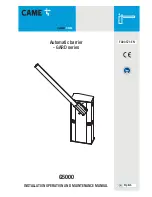
9.2 MAIN
VALVE
PARTS
INSPECTION
&
MAINTENANCE
9.2.1
GENERAL RECOMMENDATIONS
We recommend to carefully store the disassembled valves per serial number not to mix-up parts during
inspection and maintenance. Changes from one valve part to another can be invisible to the eye and
may compromise perfect valve operation during its whole life cycle.
The tools to use must be adequate in order to prevent the part damage. It is particularly true with soft
good materials, sliding surfaces and sealing ones.
9.2.2
PART INSPECTION
• Main valve body (001)
Inspect the body for any cracks, erosion, pitting. Outlet flange gasket seating area shall be in proper
condition without any impact marks. If the body has such defects it shall be replaced.
The upper body gasket seating surface roughness shall be of about Ra 1.6µm (64 RMS).
Scratches can be removed with abrasive paper grade 1000 or higher.
Inspect the seat housing for any deformation or erosion, pitting.
• Main valve studs & nuts (035 & 050)
Studs and nut shall be free of rust, and threads free of deformation and impact marks. If studs and nuts
are not in perfect shape the defected ones shall be replaced.
• Main valve cover (002)
Inspect the Cover for any cracks, erosion, pitting. If the cover has such defects it shall be replaced.
• Main valve guide sleeve (009)
Inspect the internal diameter where the spindle slides.
If surface is galled, scratched, the guide sleeve shall be replaced.
• Main valve stem (012)
Inspect the external diameter where the guide sleeve slides. It shall not have any scratches or be
galled. If this diameter is damaged carefully check the guide sleeve. It might be damaged.
Inspect the spherical area. It shall not have any scratches or be galled. If surface is galled, scratched,
corroded or pitted. The spindle shall be replaced.
FIGURE 5-GUIDE SLEEVE
FIGURE 6-STEM
22
|
www.trilliumflow.com
74LP PRESSURE RELIEF VALVE
SARASIN-RSBD
™










































